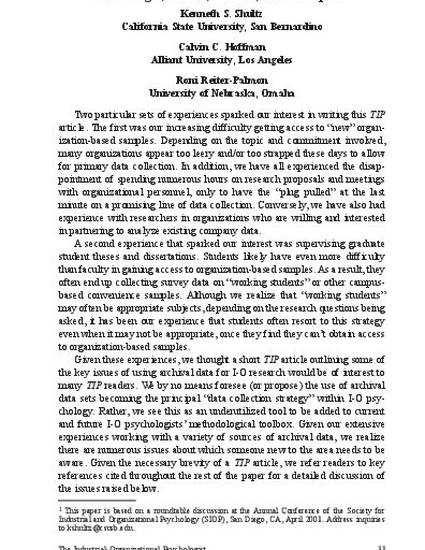
Two particular sets of experiences sparked our interest in writing this TIP article. The first was our increasing difficulty getting access to “new” organization- based samples. Depending on the topic and commitment involved, many organizations appear too leery and/or too strapped these days to allow for primary data collection. In addition, we have all experienced the disappointment of spending numerous hours on research proposals and meetings with organizational personnel, only to have the “plug pulled” at the last minute on a promising line of data collection. Conversely, we have also had experience with researchers in organizations who are willing and interested in partnering to analyze existing company data.
A second experience that sparked our interest was supervising graduate student theses and dissertations. Students likely have even more difficulty than faculty in gaining access to organization-based samples. As a result, they often end up collecting survey data on “working students” or other campusbased convenience samples. Although we realize that “working students” may often be appropriate subjects, depending on the research questions being asked, it has been our experience that students often resort to this strategy even when it may not be appropriate, once they find they can’t obtain access to organization-based samples.
Given these experiences, we thought a short TIP article outlining some of the key issues of using archival data for I-O research would be of interest to many TIP readers. We by no means foresee (or propose) the use of archival data sets becoming the principal “data collection strategy” within I-O psychology. Rather, we see this as an underutilized tool to be added to current and future I-O psychologists’ methodological toolbox. Given our extensive experiences working with a variety of sources of archival data, we realize there are numerous issues about which someone new to the area needs to be aware. Given the necessary brevity of a TIP article, we refer readers to key references cited throughout the rest of the paper for a detailed discussion of the issues raised below.
Available at: http://works.bepress.com/roni_reiter-palmon/16/

Shultz, K. S., Hofman, C. C, & Reiter-Palmon, R. (2005). Using archival data for I/O research: Advantages, pitfalls, sources, and examples. The Industrial/Organizational Psychologist, 42(3), 31-37. © 2005 Society for Industrial and Organizational Psychology, Inc. Used by permission.
The original article can be found at http://www.siop.org/default.aspx.